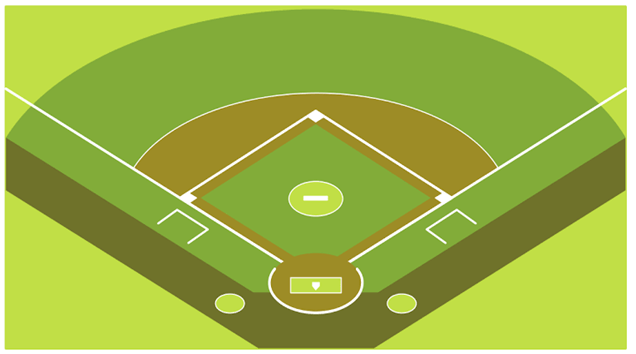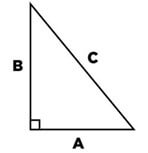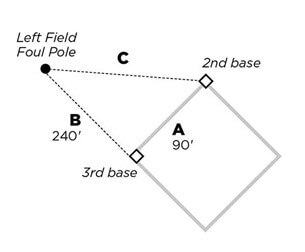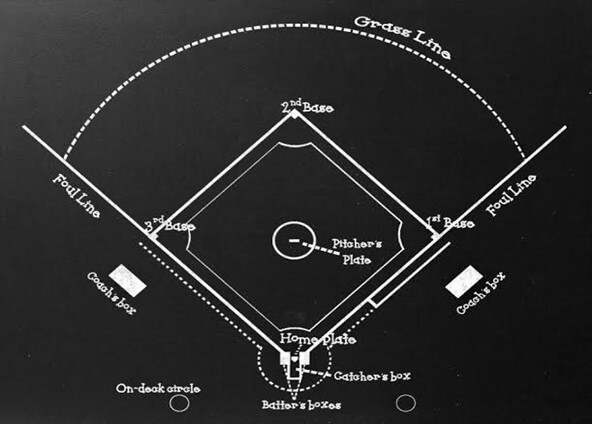Call it a baseball field, ball field, sandlot, or a baseball diamond, playing Baseball will be as entertaining as always. Though it can be played for various reasons such as school competitions, for different leagues or for just prime fun, a Baseball field needs to be laid out following a proper procedure with measurements. An exact Baseball field layout can be rough to achieve at times but becomes easier when you are already thorough with all the important measures you need to take.
Follow this guide to set up your field with correct dimensions depending upon different types of leagues that happen to be in the game of Baseball.
There can be some prominent areas you need to focus upon before even starting with your Baseball field layout. Such considering factors can include:
- Total Area Measurement (including area for bathrooms, concession areas, facilities of storage, bleachers, drainage swales, etc.)
- Safety of the Audience
- Effective Drainage System
Total Area Measurement
Including the whole area required by all important facilities which are essential in a baseball field, following may be the suggestions according to the sources that you can follow:
- 5 Acres: 90 ft bases with 400 ft fence
- 3 Acres: 80 ft bases with 315 ft fence
- 2 Acres: 70 ft bases with 275 ft fence
- 5 Acres: 60 ft bases with 215 fences
Safety of the Audience
There should be enough space between the fields and between the fields and bleachers, so people are able to walk and watch the game freely and comfortably also without directly or indirectly affecting the game.
Safety of the people can be ensured by having an overhead system of netting. Although this might be an expensive way to do that but will also be the safest measure. Extra space between the fields can also be planned to reduce risks of foul balls. Both the methods could also be followed to allow the maximum safety.
Planting more trees could be a better way to have shade and comfort and to beautify the baseball field layout.
Effective Drainage System
Having a baseball field and not taking care of the drainage can be as dangerous as possible. Surface drainage needs to be taken into consideration.
“Turtle back” is an effective technique to do so. This includes setting up of slopes along with storm drains around the out of play area edges. It will help to drain out the surface water from the field.
This sums up all the important factors need to be considered before going to the actual Baseball field layout. Since we are done with these, let us move to the areas of focus.
Basic Baseball Field Layout

Here is a basic diamond shaped diagram of the Baseball field which would help you to understand the main design and layout to get a better understanding of further procedure.
Basic Baseball Field Layout
Keep an Eye for the Position of the Sun
It is necessary to keep an eye at the sun’s position during the daytime. That is the time when mostly the games will be played. The position of the can influences each player on the diamond. Therefore, it is ideal to try and keep the sun out of the batter’s line of sight.
It is dangerous for a batter to stay and play on the pitch if the sun is directly or indirectly hitting into his/her eyes. Hence, it is the safest to have such planning of the Baseball field layout where sun would be entirely behind the batter’s head.
That is the reason why it is mostly suggested to keep the field where the sun should go from southwest to northeast while the home plate would be placed at the southwestern end.
Selection of the Position of Homeplate
Since, you are now familiar with the direction your field should be facing, let us see where the home plate should be located. It is advisable to center the home plate within the installed backstop if you have one.
Refer to the Baseball field layout diagrams for ensuring correct distance between the home plate and your backstop, use ruling jurisdiction. The backstop-to-home-plate ought to be a continuation of the sphere line from home plate to centerfield.
Lastly, wherever you would like your home plate to be settled, place a marking flag over there.
The Second Base
Start doing this by taking a 200′ or longer measuring tape and attaching one of its ends to the stake at your home plate and go on measuring within the direction where you simply wish to position the ordinal base at.
Once done with this, drive another stake at the correct distance for ordinal base which ought to be the precise center and may fall on the line of the sphere.
The First and the Third Base
It is mandatory to keep in mind that before going on the third base, you need to focus on the first one. You need to measure the distance between your second and first base (approximate) by using a measuring tape.
Now take another measuring tape and follow the same step but from home plate. Distance between the second and the first plate, and between the first and the home plate should be the same. This will mark the position of your first plate to be placed exactly. Follow the same and repeat the same steps to place the third base.
Pitching Mound
In this case, you need to be aware of the rules of your league and that too distance wise. After that you just need to take measurements of the apex of the home plate to the distance where your pitching mound would be placed, that will be in the direction of the second base.
There is no need to include the black outside edging on the plate since it is not included in the part of the home plate.
Locating Foul Poles
Locating the foul poles in a Baseball field layout requires a bit of maths. Nevertheless, it is merely an easy formula of the right triangle, that is:
A² + B² = C²

The basic diagram of the geometric formula used for the calculation of the foul poles.
Let us understand this in short points.
Find: Left field foul line
Let A= distance between second and third base
Let B= distance you wish your foul line to extend till the third base to your foul pole.
Now, take both the numbers and square them according to the formula and then, find out the sum of them that is the total of both numbers. Find out the square root of the sum you just calculated to get the value of C (the hypotenuse).
Since you have the values of your A, B and C you are free to locate the foul poles accordingly.

Here you can refer to a diagram of a foul pole calculation.
Well, this was the general procedure of having a Baseball field layout. Now let us look at some specific baseball leagues.
These can vary from Pinto Baseball field, Little League Baseball Field, Bronco Baseball Field, Pony Baseball Field to High School, College, and Pro Baseball
Fields. When we look at all these different types a question pops up naturally in our mind that does each of them demand different dimensions to go? Let us say yes, they do but the basic Baseball field layout remains the same only there can be some changes depending on the uses of it.
Below are listed the dimensions depending upon each type of league from where you can refer and choose one to depend upon your own requirements and needs. These are the same dimensions and measurements which are also suggested by some of the professional Baseball field layout guides.
Pinto Baseball Field
- Baseline: 60 feet
- Home plate to second base: 70 feet 8 1/2 inches
- Home plate to front of pitching rubber: 38 feet.
- Infield arc radius: 50 feet
- Home plate to backstop: 20 feet
- Foul lines: 125 feet to fence.
- Center field fence: 175 feet
- Pitching Mound Diameter 10′
- Pitching Mound Height 6″
Little League Baseball Field
- Baseline: 60 feet
- Home plate to second base: 84 feet 10 ¼ inches
- Home plate to front of pitching rubber: 46 feet.
- Infield arc radius: 50 feet
- Home plate to backstop: 25 feet
- Foul lines: 200 feet minimum to outfield fence
- Center field fence: 275 feet
- Pitching Mound Diameter 10′
- Pitching Mound Height 6″
Bronco Baseball Field
- Baseline: 70 feet
- Home plate to second base: 99 feet
- Home plate to front of pitching rubber: 50 feet.
- Infield arc radius: 65 feet
- Home plate to backstop: 30 feet
- Foul lines: 225 feet to outfield fence
- Center field fence: 275 feet
- Pitching Mound Diameter 12′
- Pitching Mound Height 6″
Pony Baseball Field
- Baseline: 80 feet
- Home plate to second base: 113 feet 2 inches
- Home plate to front of pitching rubber: 54 feet.
- Infield arc radius: 80 feet
- Home plate to backstop: 40 feet
- Foul lines: 265 feet to outfield fence
- Center field fence: 275 feet
- Pitching Mound Diameter 15′
- Pitching Mound Height 8″
High School, College, and Pro Baseball
Field
- Baseline: 90 feet
- Home plate to second base: 127 feet 3 3/8 inches
- Home plate to front of pitching rubber: 60 feet 6 inches.
- Infield arc radius: 95 feet
- Home plate to backstop: 60 feet
- Foul lines: 325 feet minimum to outfield fence
- Center field fence: 400-plus feet
- Pitching Mound Diameter 18′
- Pitching Mound Height 10″
Hope this guide helps you to have your perfect Baseball field layout followed by all good and superb games.

